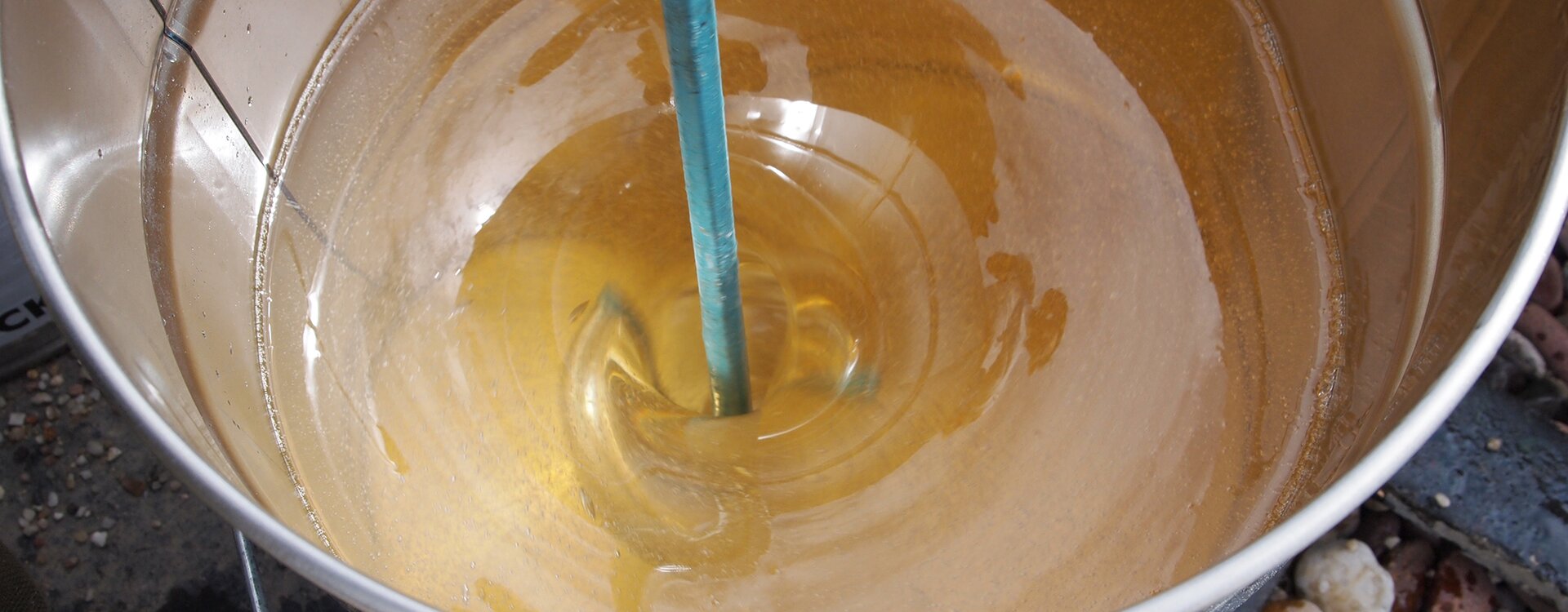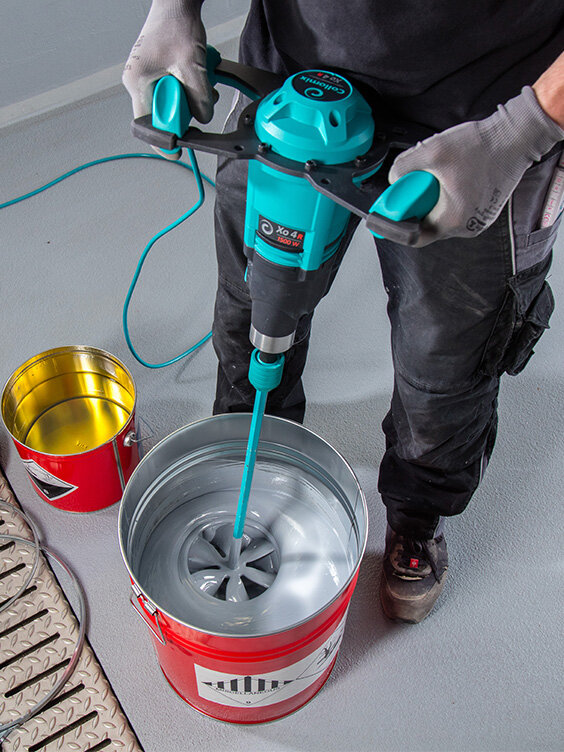
The Benefits of Mixing Properly
Collomix's Guide to How to Mix Paint and liquid Epoxy Resins Quickly and Effectively
As a professional in the engineering and construction industries, you know that time is money. Money spent on labor, on project delays, and on overtime because your project isn't coming together as quickly as you had hoped. But at the same time, mixing epoxy resin or paint too quickly can cause serious problems such as streaking, sticky spots, poor curing, uneven strength, and similar concerns. That can lead to an extensive time being invested in repairs instead of moving onto the next project or task.
For these reasons, the experienced professionals at Collomix have developed this guide on how to mix epoxy resin and paint effectively, so you know which high-quality tools and techniques to use. This will help you get the job done faster, so you can get onto the next task on your list without compromising the integrity of your project or materials. As a strong supporter of the construction industry, Collomix's high-quality tools can help you save time and effort on the job site.
For the most part, mixing epoxy resin and mixing paint have very similar approaches, but there are significant differences that can save you time and effort but still provide outstanding results. Though both materials will be stirred, the difference in consistency and set time change the tools and techniques you select for the job. For that reason, you can find the specific instructions for each type of material below.

How to Mix Paint
Generally speaking, paint is usually ready-mixed shortly before it is needed using a shaker or similar piece of equipment at the warehouse or paint dealer. However, if the paint has sata while, it will begin to separate, requiring additional mixing at the project site. Though many contractors simply grab a stir stick, this approach is more time-consuming, therefore cutting into your efficiency and productivity. Stir sticks, though effective enough to be given away for free, are only the best option for homeowners and very small homogenization tasks.
As a professional, you need to get the job done much more quickly, even if it's just a quick stir to get everything back into order to prevent streaks of pigment or color in your painting. For that reason, we recommend that contractors use our LX or FM paddels, stepping up to the DLX paddle for larger quantities of paint that must be mixed quickly and thoroughly. As these paddles are sometimes also used for mixing epoxy resin, we'll discuss them in more detail below, providing you with all the information you need to make a smart choice of mixing tools.
How to Mix Liquid Epoxy Resin
Though mixing liquid epoxy resin takes a similar approach to mixing paint, there are some very significant differences that must be addressed. These differences may impact the quality of the resin, the number of bubbles that develop, and which paddle you should use to get the best results. Bubbles are a common enemy in epoxy, causing issues with strength and durability. As a two-part epoxy, these fast-setting materials must be combined on your construction or project site, as they will set up after a certain period of time following the mixing process.
Unlike paint, which will allow bubbles to rise to the surface and pop, the higher viscosity of epoxy resin can make this process more difficult. For that reason, reducing bubbles in the mixing process is very important to the quality of the final work. Therefore, it is crucial to consult your epoxy resin mixing ratio chart to ensure proper mixing for the different viscosities being applied in the field. For this reason, we would add the KR paddle to the prior list, as it deals better with thicker epoxies.
Tips and Tricks for How to Mix Paint in the Field
Depending on how long your paint has been sitting - we see you, last-minute touch-ups - you'll need to stir your paint for a minute or two. At a minimum, you'll want any bands of color that appear at the top to be completely incorporated into the paint before you stop stirring. The amount of time that you'll need will depend on how separated the paint it is, the type of paint that it is, and the type of paddle that you are using.
Paint that was shaken that morning may only need a perfunctory stir, while that which has sat for several weeks will be much more extensive. If you're going between paint canisters, such as moving from one five-gallon can to another, and they were mixed on different days, you may want to mix equal portions together in a separate bucket. Use a portion of that, add the same amount of the new bucket, mix and paint again, and then finally switch entirely to the new container to mediate any change in tone between the two batches.
Tips and Tricks for How to Mix Epoxy Resin in the Field
Mixing epoxy resin is a bit trickier in the field, as it sets up much faster than paint once it is mixed. Generally speaking, paint will remain liquid for a very long period of time, provided that it is protected from exposure to air. Epoxy resin, on the other hand, will set up relatively quickly once mixed and cannot be hindered through sealing. It needs to be mixed more carefully to prevent bubbles, which may remain due to the thicker viscosity of the liquid and faster setting time.
To start, pay attention to the ratio used in the epoxy resin mixing ratio chart. Some are a simple 1:1 or 2:1, but others are much more complex, such as a 45:100 ratio. Failing to mix the epoxy resin at the proper ratio can cause the epoxy to not set up or spread properly. Measure the epoxy resin parts by volume rather than weight, as the component parts may have different masses. Measuring cups, buckets, or other volumetric measuring devices should work well for this purpose.
Next, look at your environmental conditions. Most epoxy resins will set up best at 20C/68F in terms of both the surrounding and surfacce temperatures, with the process slowing down in cooler temperatures and speeding up in higher temperatures. Humidity can also play a part in the process, with humidity above 65% when opening the hardener container detrimentally affecting it and above 70% during curing will cause problems with your project.
If the parts of your epoxy resin are stored in a cool location, make sure to bring them to the location about 12 hours in advance of mixing so that they can warm up to the localized temperature. For rush projects, where setting time is of the essence, heating the location and surface during and after the application of the epoxy resin can make a big difference. Similarly, you'll want to dry damp areas prior to applying an epoxy resin.
Finally, mix the components thoroughly but carefully, being careful to avoid too high of speeds that may cause air bubbles to form due to splashing or air being folded into the mixture. If the components are not completely mixed, you may have localized areas of tackiness or stickiness, incomplete curing, or inconsistent hardening of the epoxy. This process should take a few minutes if done properly. If you do have bubbles appear, you may be able to pierce larger ones early in the process.

Collomix Products for Mixing Epoxy Resin and Paint
LX Paddle. For mixing smaller quantities in a very fast manner, the LX paddle is designed to quickly create strong flow from the bottom up in thinner materials. It provides optimal flow when high-speed drives are used with the paddle, allowing a constant flow to form from the bottom to the top and back down the sides.
FM Paddle. Shaped as a classic paddle for mixing paint, the FM paddle is able to work with a range of different materials, making it a workhorse on the job site. It works well with average machine loads and can work very well for use for the DIY homeowner as well as for professional purposes.
DLX Paddle. When you need to quickly stir a large quantity of material, the DLX paddle has two offset paddles in the style of the LX paddle, providing more action and flow to quickly mix materials in larger quantities without incorporating bubbles into the mix. It can also be used with thin cementitious materials, such as soft or viscous grout and self-leveling flooring material.
KR Paddle. Designed to help prevent the formation of lumps, the KR paddle is capable of generating high shear forces to mix viscous materials, including thicker epoxy resins. It's also designed to be easier to clean as the material will not stick to the stirrer paddle, saving your crew time on the job at the end of the day.
Collomixer Mixer Drills. No matter which paddle you decide to go with for your mixing needs, you're going to need a high-quality motor to power that mixing tool. Though some companies try to use drills to power the tool, this can lead to inconsistent results and due to the lack of power and torque that most drills can transmit. For that reason, we recommend using the suitable Collomixer Mixer Drill with your paddle for optimal results, timing, and effects.

A Double-paddle Mixer is the ultimate solution for all epoxy professionals
For mixing larger quantities or thicker epoxy materials, the use of a double-spindle mixer can be the ideal solution. There is no faster and more thorough way than with such a machine.
Why Collomix?
When you need to know how to mix epoxy resin or paint, one of the most important aspects of this process is having the right tools for the job. At Collomix, our dedication to providing the engineering and construction industries with high-quality tools that feature the very best of German engineering is only matched by our dedication to outstanding customer service.
